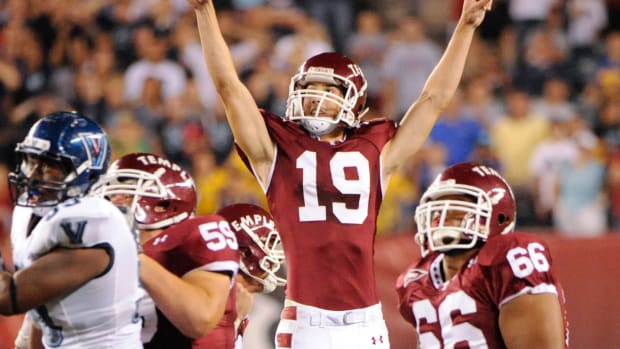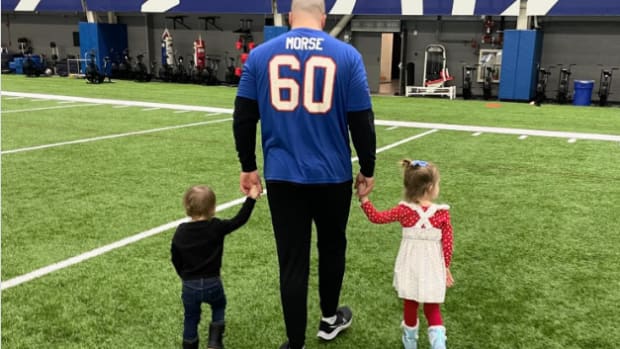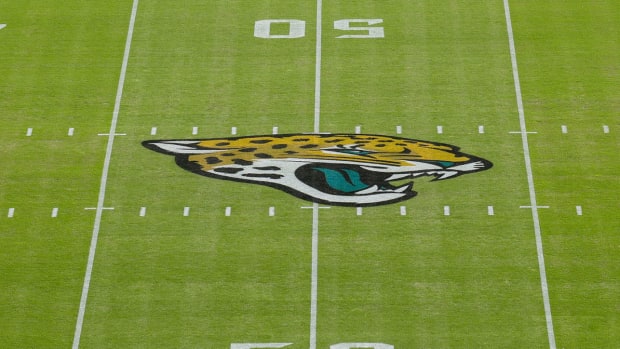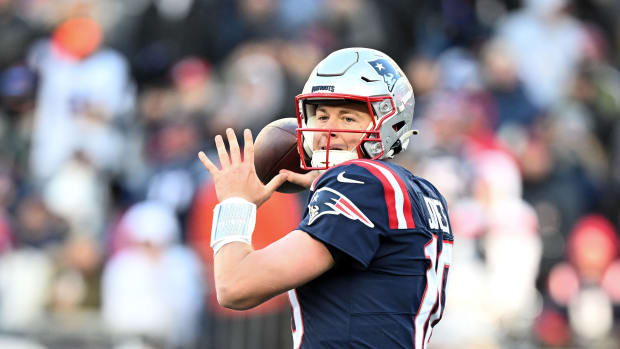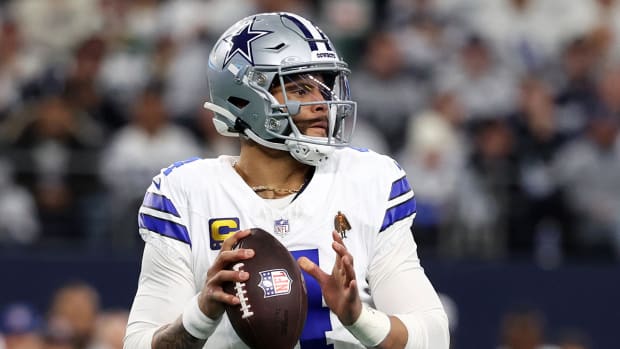8 Thoughts on the Jaguars’ 2021 Draft: Aggressive Moves, Surprise Picks and Trends To Watch
My favorite event in the sporting calendar is officially over; the latest NFL Draft has come to a close and dreams have been realized for over 250+ athletes and their families.
The three-day event was especially eventful for the Jacksonville Jaguars, who held the draft's top pick and entered the weekend with 10 selections. The Jaguars used nine of those picks (trading one other away for Jordan Smith), and drafted a franchise quarterback in Trevor Lawrence.
What do we make of the Jaguars' draft class? What did it show us about how the team could operate moving forward? We break it down here.
The Jaguars made the most of their historic selection at No. 1 overall, but now the pressure is on Urban Meyer and Trent Baalke, not Trevor Lawrence
Jacksonville didn't dance around the issue at No. 1 overall, making the clear and obvious choice in Clemson quarterback Trevor Lawrence to be their new franchise quarterback. They then spent two of their next three picks providing Lawrence with a weapon he is familiar with in Travis Etienne and his likely future blindside protector in Walker Little. The Jaguars spent their other top-100 picks in the secondary and took defensive players with their first two picks on Day 3, but they more or less made the most of their selection of Lawrence.
But now, the pressure is on the Jaguars to make sure Lawrence becomes nearly as as successful most evaluators project he will. If Lawrence fails to live up to the lofty standards, the focus will be on the Jaguars for failing him, not vice-versa; the magnifying glass of scrutiny will especially be on Shad Khan's hiring of Urban Meyer. Hiring Meyer would be risky for any NFL team considering his lack of NFL experience, but the Jaguars have to balance it with the fact that they now have to support and develop one of the NFL's latest great quarterback prospects.
Was Urban Meyer looking at the right offensive weapon targets at No. 25?
With Urban Meyer's admission that he wanted to draft Florida wide receiver Kadarius Toney at No. 25 overall (he was selected by the Giants at No. 20), and then his actual selection of Clemson running back Travis Etienne with the draft's 25th pick, it is easy to see that Meyer had his eye on adding a dynamic offensive weapon with the Jaguars' second first-round selection. Regardless of how the board fell, it certainly appears Meyer was going with a dual-threat who could create explosive plays and score from anywhere on the field.
But were Toney and Etienne the right players at No. 25? In Toney, the Jaguars would have gotten an exciting athlete who has rare ability with the ball in his hands, but a raw receiver prospect with one year of production and poor route running skills. With Etienne, the Jaguars sacrificed considerable value for a running back who isn't equipped to be a pass protector. With that said, each is among the most explosive home run hitters in the entire class and each would qualify as the most dynamic athlete on the Jaguars' offense.
With this in mind, I can't help but think Meyer could have found similar traits elsewhere. He wanted Toney at No. 25, but a similar and more productive player in Elijah Moore was drafted at No. 34. And Etienne is a great player but the value is so questionable in large part because since similar pass-catching backs Michael Carter and Kenneth Gainwell were both drafted on Day 3. Meyer's targets in the first-round were clear, but we will see if he had his eyes on the right targets.
Outside cornerback class dried up starting with the Jaguars' selection of Tyson Campbell, which could help explain the surprise pick
The Jaguars' selection of Tyson Campbell at No. 33 surprised a lot of people for a few reasons; the outside perception on the Jaguars' cornerback room was that the team was set, but the Jaguars wanted another starting-caliber option to develop. The Jaguars were also frequently mocked TCU safety Trevon Moehrig and Alabama defensive lineman Christian Barmore throughout the spring, so the Jaguars passing on both in favor of Campbell was a surprise for many.
But, just look at the cornerbacks drafted after Campbell: Kelvin Joseph (No. 44), Asante Samuel Jr. (No. 47), Aaron Robinson (71), Benjamin St-Juste (74) and Paulson Adebo (No. 76). Samuel Jr. and Robinson are not ideal scheme fits, so it is more so down to Joseph, St-Juste, and Adebo. The selection of Campbell and the gap in corners taken after him shows he wasn't lasting very long past No. 33 if the Jaguars didn't take him -- ultimately, the Jaguars had a better shot of Moehrig being there at No. 45 than they did of Campbell. The pick is still a bit surprising to many for the aforementioned reasons, but how the cornerback market played out explains why the Jaguars made the move when they did.
The tight end fallout
The Jaguars waited all the way until their eighth selection to pick a tight end, taking hardly utilized Ohio State blocking tight end Luke Farrell in the fifth-round. Farrell will be instant depth behind starting tight end Chris Manhertz, but it remains to be seen what kind of passing-game impact he can make. And in waiting as long as they did to address tight end, the Jaguars passed multiple times on Pat Freiermuth (No. 55), Hunter Long (No. 81), Tommy Tremble (No. 83) and then finally they picked Farrell over Miami's Brevin Jordan, who was taken two selections after Ferrell at No. 157 overall.
By passing on players like Freiermuth and Long multiple times even know the Jaguars had excellent intel on both prospects says a lot. Them passing on Jordan to add a backup blocking tight end says even more. Ultimately, the Jaguars' tight end room is a wasteland in terms of proven pass-catchers, but this draft shows me the Jaguars really may not care that much. The tight end position, at least for 2021, can compliment the offense as extensions of the offensive line and in the red zone. Otherwise, the Jaguars are better off getting the ball to DJ Chark, Laviska Shenault, Marvin Jones, or Travis Etienne. The Jaguars operated like a team with this belief last weekend.
The Jaguars' picks I thought stood out the most
I am absolutely fascinated by each of the Jaguars' second-round selections. Adding Tyson Campbell, who I evaluated more so as an outside press cornerback as opposed to a nickel option, creates an interesting dynamic with CJ Henderson also in the fold. Shaquill Griffin is a lock to start, so the long and speedy Campbell will have to ultimately figure out a way to share snaps with Henderson, the No. 9 overall pick from a year ago. Campbell wasn't one of my top cornerback prospects, but he makes a lot of sense for the Jaguars from a fit perspective. If they can develop both him and Henderson, this risky pick could pay off more than any non-Lawrence selection.
Then there is the Little pick. I have a gut feeling the Jaguars would have taken Moehrig at No. 45 had he fell, but he was drafted by the Raiders at No. 43 overall. They instead took a big leap on Stanford offensive tackle Walker Little, whose projection is a bit unpredicented. He has played one game in two seasons due to an ACL injury in 2019 and opting out due to the COVID-19 pandemic last season. If he could have been drafted after the 2018 season, he is likely a top-15 pick. Can the Jaguars make up for two lost years of development at a position that is already tough for players to make the jump from the college to the NFL? There is no real example of past top-50 pick left tackles with backgrounds similar to Little, so there is no real way of using history to predict how the selection could play out.
Interesting trends to watch moving forward
One of my favorite things to monitor when regimes are around for enough years to build a reliable pool of data is to look at which trends regimes live by. Whether it is drafting big-school talent or using strict athlete baselines, you can find out a lot about a regime and who they may have interest on in the future when you are able to find trends in their current moves. It is tough to do so for the Jaguars today since Meyer and Baalke each are just one offseason into their player acquisition process, and they didn't draft any two players at the same position.
With that said, there are a few trends I tried to find, namely where the Jaguars were finding their talent. Overall, the Jaguars drafted eight of their nine picks out of the Power Five conferences, with UAB edge rusher Jordan Smith the lone player who wasn't from a major program, though it should be noted he is a former Florida Gator transfer. The Jaguars drafted four players from the ACC, one from the SEC, two from the Pac 12, one from Conference USA, and one from the Big 10.
The other noticeable trend from the weekend was how many former top recruits the Jaguars targeted. This is true for most teams since the draft is made up of mostly top recruits at the top of the order, but Meyer and the Jaguars drafted three five-stars, four four-stars, one three-star, and one two-star. The only two of their top five picks who weren't former top-12 recruits were Travis Etienne (4-star, No. 213 overall) and Andre Cisco (3-star, No. 929 overall). Meyer and the Jaguars leaned on his recruiting ties and his staff's knowledge of the draft class' development since high school, leading to the Jaguars adding several former top recruits in Meyer's first draft.
Andre Cisco vs. Trevon Moehrig, Walker Little vs. Teven Jenkins will likely be the two "what if's" to watch moving forward
People will debate every single one of the Jaguars picks outside of Trevor Lawrence for years to come, but I don't think any two picks will be debated more than Walker Little and Andre Cisco's (and Tyson Campbell's by proxy). The Jaguars were always bound to reach at No. 25 overall due to how this draft class was structured, but the Jaguars' actions on Day 2 will be hotly debated for some time.
Jacksonville's selection of Campbell led to them passing on Trevon Moehrig and Teven Jenkins at different points. Moehrig and Jenkins were not only high-caliber prospects frequently mocked to the Jaguars in the past, but they played positions the Jaguars addressed with their non-100 picks following the selection of Campbell. If Cisco can develop to be the player Moehrig is at the NFL level, and if Little is as successful at left tackle as Jenkins ends up being in Chicago, then the Jaguars made the right call. But if this doesn't happen, the Jaguars will likely be left wondering "what if?" at different points.
The Christian Barmore decision
Another reason the Jaguars' decision to draft Campbell at No. 33 overall was so surprising is because it led to them directly passing on Alabama defensive tackle Christian Barmore for the second time. Barmore was the first defensive tackle drafted and was the consensus No. 1 defensive tackle in the entire draft class, so the Jaguars passing on him twice was a bit of a shock on my end. With that said, the Jaguars made up for it with the later selection of USC defensive tackle Jay Tufele.
What the Jaguars' decision to not draft Barmore tells me, however, is they saw outside cornerback as a bigger need than defensive tackle -- or at least Barmore wasn't as high on their board as so many presumed he would be. This could give us a hint as to how defensive back-heavy the scheme is going to be, as well as how low the Jaguars potentially were on Barmore considering Meyer, defensive line coach Tosh Lupoi and assistant head coach Charlie Strong all have deep dies to the Crimson Tide program.
Thoughts on rest of the 2021 NFL Draft ...
- Kudos to the Bears for being aggressive in getting Justin Fields. I didn't think Ryan Pace would be so bold in his search to finally find a quarterback. And while I really liked the players the Panthers, Broncos, and Eagles got, I find it hard to believe that cornerbacks and a wide receiver were better options than Fields considering the other options are Sam Darnold, Drew Lock, and Jalen Hurts.
- Jets had one of my favorite first few rounds. I don't love the idea of trading up for a guard, but Alijah Vera-Tucker and Mekhi Becton could be one of the best left sides in football. Elijah Moore will be a star by Year 2, while Michael Carter in the fourth is excellent value considering he is already their best running back.
- I loved the Lions' draft class, even if they passed on Justin Fields. Their first five picks are all players I loved for the next level, and I think Sewell can be the best non-quarterback in the draft class. I think they will be bad enough to land their quarterback next year, too, unlike the Panthers and Broncos.
- Non-first round fits I love: Asante Samuel Jr. to Chargers, Jevon Holland to Dolphins, Dyami Brown to Washington Football Team, Tylan Wallace to Ravens, Jamar Johnson to Broncos, Trey Smith to Chiefs, and Khyiris Tonga to the Bears.
